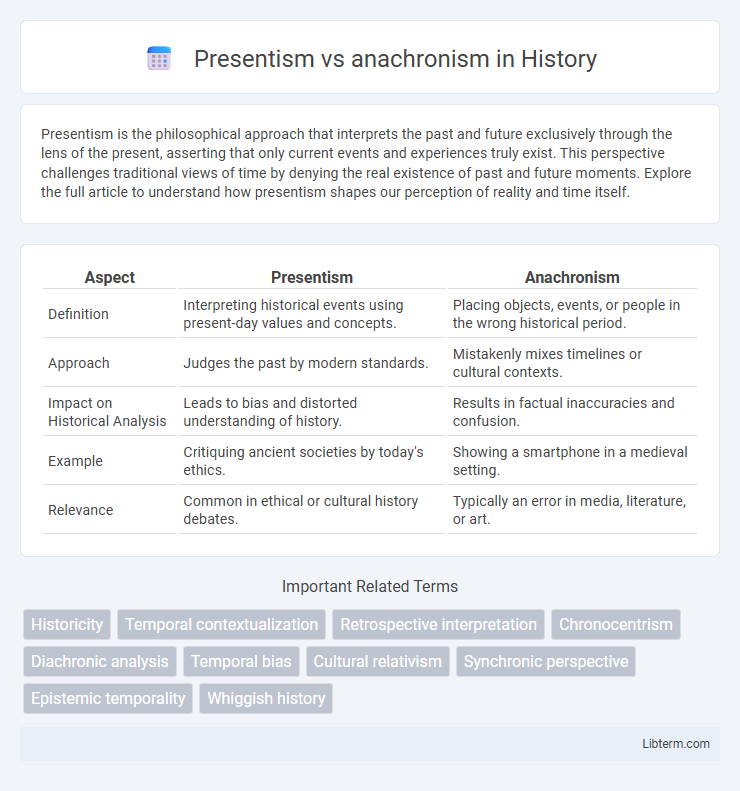Presentism is the philosophical approach that interprets the past and future exclusively through the lens of the present, asserting that only current events and experiences truly exist. This perspective challenges traditional views of time by denying the real existence of past and future moments. Explore the full article to understand how presentism shapes our perception of reality and time itself.
Table of Comparison
| Aspect | Presentism | Anachronism |
|---|---|---|
| Definition | Interpreting historical events using present-day values and concepts. | Placing objects, events, or people in the wrong historical period. |
| Approach | Judges the past by modern standards. | Mistakenly mixes timelines or cultural contexts. |
| Impact on Historical Analysis | Leads to bias and distorted understanding of history. | Results in factual inaccuracies and confusion. |
| Example | Critiquing ancient societies by today's ethics. | Showing a smartphone in a medieval setting. |
| Relevance | Common in ethical or cultural history debates. | Typically an error in media, literature, or art. |
Defining Presentism and Anachronism
Presentism refers to the interpretation of historical events or figures through the lens of contemporary values and knowledge, often leading to biased or anachronistic judgments. Anachronism occurs when elements, ideas, or practices are incorrectly attributed to a period to which they do not belong, distorting historical accuracy. Both presentism and anachronism challenge objective historical analysis by imposing modern perspectives on past contexts.
Historical Roots of Presentism
Presentism, rooted in the Enlightenment's emphasis on progress and rationality, interprets historical events through contemporary values and knowledge. This approach contrasts with anachronism, which inaccurately attributes modern ideas or artifacts to past contexts without considering historical developments. Understanding presentism's origins in 18th-century historiography reveals its impact on how scholars assess historical figures and events using today's ethical and intellectual standards.
Understanding Anachronism in Context
Anachronism arises when objects, ideas, or events are placed outside their proper historical period, distorting accurate cultural or temporal understanding. Recognizing anachronism within its context requires analyzing historical frameworks and avoiding the imposition of modern values on past societies. Accurate interpretation depends on situating events and artifacts within their authentic chronological and cultural settings to prevent presentist bias.
Presentism in Modern Historical Analysis
Presentism in modern historical analysis refers to the interpretation of past events through the lens of contemporary values and knowledge, often leading to biased or anachronistic conclusions. This approach risks distorting historical contexts by imposing present-day moral standards or social norms on societies that operated under different frameworks. Historians emphasize the importance of understanding historical actors within their own time to avoid presentism and achieve more accurate, nuanced interpretations.
The Dangers of Anachronistic Thinking
Anachronistic thinking distorts historical understanding by imposing contemporary values and perspectives onto past events, leading to misleading interpretations and judgments. This cognitive bias obscures the context of historical actions, undermining the complexity and authenticity of cultural and social developments. Recognizing these dangers is essential for accurate historiography, preventing the oversimplification of history and fostering a more nuanced comprehension of temporal differences.
Presentism vs Anachronism: Key Differences
Presentism interprets historical events and figures through contemporary values and perspectives, often leading to biased judgments. Anachronism involves mistakenly placing objects, ideas, or events outside their correct historical period, causing factual inaccuracies. The key difference lies in presentism's projection of modern viewpoints on the past, while anachronism is a chronological error disrupting historical accuracy.
Impact on Cultural Interpretation
Presentism, the practice of interpreting historical events through the lens of contemporary values, often distorts cultural interpretation by imposing modern norms that were nonexistent in the past. Anachronism, the misplacement of objects or ideas in the wrong historical context, similarly disrupts accurate cultural understanding by creating false temporal associations. Both presentism and anachronism hinder authentic engagement with historical cultures, leading to misinterpretations and oversimplified narratives.
Presentism and Moral Judgment
Presentism involves interpreting historical events and figures through the lens of contemporary moral standards, often leading to judgments that do not account for the context of their time. This approach can distort understanding by imposing modern values on past actions, thereby oversimplifying complex historical realities. Evaluating moral behavior within its original social, cultural, and ethical frameworks is essential to avoid the pitfalls of anachronistic bias.
Avoiding Anachronism in Scholarship
Avoiding anachronism in scholarship requires analyzing historical events and ideas within their specific temporal, cultural, and social contexts to prevent present-day biases from distorting interpretations. Rigorous examination of primary sources, awareness of contemporary values, and sensitivity to the distinct worldview of past societies enhance accuracy and authenticity. This methodological discipline preserves intellectual integrity and fosters a nuanced understanding of historical phenomena.
Navigating the Tension in Contemporary Debates
Navigating the tension between presentism and anachronism requires critical engagement with historical context while acknowledging contemporary values shaping interpretation. Scholars emphasize balancing accurate representation of past events without imposing modern moral frameworks, thus avoiding distorted analyses or oversimplifications. This nuanced approach fosters richer understanding in debates about cultural heritage, ethics, and historiography.
Presentism Infographic

 libterm.com
libterm.com